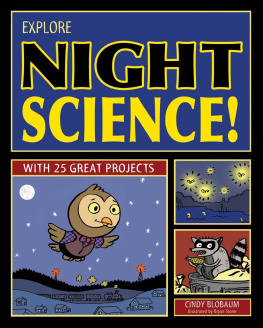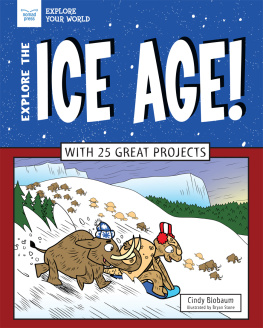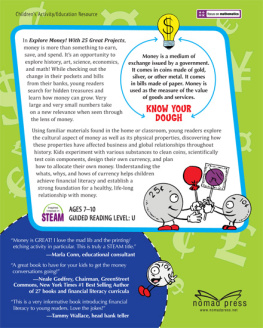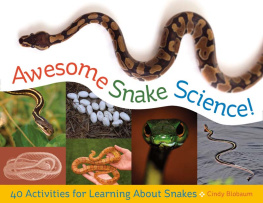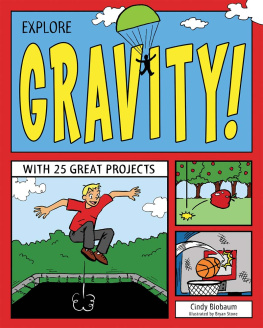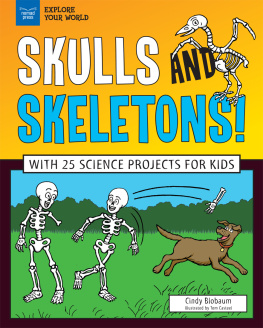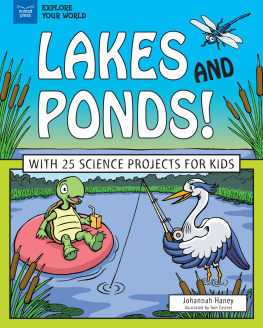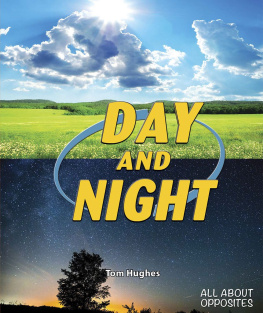For Anna, who is always ready to stay up late and explore the night.
Nomad Press
A division of Nomad Communications
10 9 8 7 6 5 4 3 2 1
Copyright 2012 by Nomad Press. All rights reserved.
No part of this book may be reproduced in any form without permission in writing from the publisher, except by a reviewer who may quote brief passages in a review or for limited educational use.
The trademark Nomad Press and the Nomad Press logo are trademarks of Nomad Communications, Inc.
Illustrations by Bryan Stone
Educational Consultant, Marla Conn
Questions regarding the ordering of this book should be addressed to Independent Publishers Group
814 N. Franklin St.
Chicago, IL 60610
www.ipgbook.com
Nomad Press
2456 Christian St.
White River Junction, VT 05001
www.nomadpress.net
CONTENTS
Chapter One
When and Why Is It Night?
Chapter Two
Seeing the Night
Chapter Three
Hearing the Night
Chapter Four
Smelling the Night
Chapter Five
Feeling the Night
Chapter Six
Night Lights
Titles in the Explore Your World! Series

Introduction

Open the door after the sun goes down and before it rises again. Step out into the dark. Most colors look gray or black. Do sounds jump out at you? Do smells seem stronger? How does the air feel? Is it different from the way it feels during the day?
WORDS TO KNOW
night: the time after the sun sets and before the sun rises, when it is dark.
migrate: to move from one place to another.
Night is different from day, whether you live in the country or in a city. What you see in the sky changes. Different animals are active. Different plants bloom. And what happens at night changes with every season of the year. Star gazing and owl calling are best on winter nights. Moth catching and bat watching are summer night activities. Spring and fall are when many animals have babies or migrate, often when it is dark.
What do you need to explore night science? Mostly, you need your senses. Your eyes, ears, nose, and skin are your most important tools. The way you see, hear, smell, and feel changes at night. By testing your senses in the dark, youll learn how to improve them and use them better.
When should you explore the night? Some night scientists stay up late. They do their studies after it gets dark. Other night scientists wake up early. They do their studies before it gets light.
WORDS TO KNOW
night science: the study of the natural world at night.
senses: seeing, hearing, smelling, touching, and tasting. These are ways that people and animals get information about the world around them.
Youll discover that some nights are longer than others. During winter, long nights mean you dont have to stay up too late or wake up too early to do your experiments. But not everything happens on winter nights. Plan some exploring time for weekends in the other seasons. Then you can sleep during the day if youre tired from staying up late.


HOW DO YOU GO FOR DAYS WITHOUT SLEEP AND NEVER FEEL TIRED?
Sleep at night!
Most of the activities in this book work best in the dark. But before you start, get the materials ready where it is light. While some activities should be done outside, others can be done inside in a dark room or basement. Its usually okay if there is a little light. Most nights arent completely dark either.
WORDS TO KNOW
supernova: an exploding star.
galaxy: a group of millions or billions of stars. The earth is in a galaxy called the Milky Way.
light year: a unit of measure for very long distances. One light year is the distance that light travels in a year, about 6 trillion miles (9.5 trillion kilometers).
Night is your chance to explore a new world. You dont have to travel far. You dont need tools that cost a lot of money. And you might even discover a whole new world!
SUPERNOVA DISCOVERY
Kids can be night scientists! In January 2011, a 10-year-old girl named Kathryn Aurora Gray from New Brunswick, Canada, became the youngest person to discover a supernova. Scientists find supernovas by comparing photos taken on different nights in far-away galaxies.
Kathryn and her dad were looking at 52 photos taken of the night sky in a galaxy 240 million light years away. Kathryn noticed a new light in the fourth picture and asked her father, Is that one? After more research, she and her dad were sure. Kathryn became the first person to identify the supernova known as SN2010lt that exploded 240 million years ago.
When and Why Is It Night?

Night starts when the sun disappears below the horizon. Some light stays in the sky for a while. This time is called dusk. Night ends when the sun peeks above the horizon. There may already be some light in the sky even before the sun moves above the horizon. This time is called dawn. The light you see at dusk and dawn is called twilight.
WORDS TO KNOW
horizon: the line that separates the land from the sky.
dusk: the time after the sun goes below the horizon, when there is still sunlight in the sky.
dawn: the time before the sun rises above the horizon, when there is sunlight in the sky.
twilight: light that is visible in the sky at dawn and dusk, when the sun is below the horizon.
There is twilight because Earth has an atmosphere. Our atmosphere is like an invisible blanket wrapped around the planet. The suns rays bounce off the air, water, clouds, and dust that make up the blanket of the atmosphere. Some of that bouncing light comes down to Earth where you can see it in the sky.

WORDS TO KNOW
atmosphere: the layer of gases that wraps around the earth.
water vapor: water as a gas, like fog, steam, or mist.
The more things that are in the atmosphere near you, the more it splits the sunlight into different colors. So if there is a lot of smoke from a fire or water vapor in the atmosphere, the clouds and sky at twilight might have shades of purple, pink, red, and orange.


